
Pancakes and Politics — Nov 2018 Voter Guide
By: Johnny Pancake, Mabel Sirupa, & anonymous authors of the People’s Republic of Davis
Illustrations: Danielle Fodor (cc-nc-nd)
The Infamous Intro (aka what the xH&$*H!! is this about??)
Every election a group of Davis residents meets to stuff food into our gullets, discuss the upcoming election, and put out a whimsical Voter Guide. And we always come through . . . sometimes.
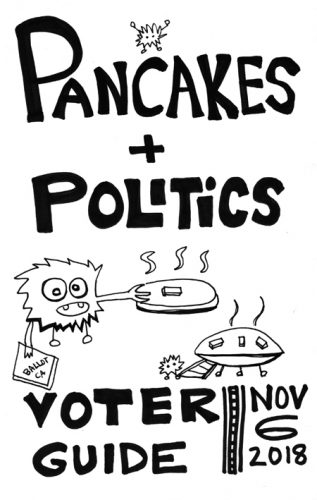 This zine is a record of an event. The event of people making pancakes. The event of people talking politics. To be more specific…
This zine is a record of an event. The event of people making pancakes. The event of people talking politics. To be more specific…
We came, we met, we made pancakes.
We talked, we argued, we interrupted each other.
We appointed a timekeeper. He went out to play.
We appointed a facilitator. She abandoned her duties to draw.
We appointed a queue keeper. He tired of people ignoring him, and stopped keeping the queue.
Things…. happened. Somehow, we still (mostly) liked each other at the end of the afternoon. Homemade jam helped. Like the democracy itself, we are a flexible group. We cover for each other, and try not to make a fuss.
After all, there are more important things to make a fuss about — no? Like housing for the poor. Damming the few wild stretches of rivers we have left. Hospitals and health care. Time itself, and our measurement thereof.
Which is to say, I bear no easy answers for the choices that face you, brave voter. All I can do is advise you of our conversation, and hope it may aid you on your journey through our electoral system. Some might say this zine is a straw man — nay, yet it is full of straw polls.
Read on, brave voter.
For a for a downloadable pdf version of the Voter Guide click HERE .
There is also a DavisWIKI version at this link.
Local (Davis and Yolo) Measures
Measure L — Active Adult Community
Measure L would authorize the creation of the West Davis Active Adult Community (WDAAC) by amending the general plan to turn 74 acres of agriculturally zoned land into residential & mixed-use.
Tucked into the northwest corner of Davis by Sutter Hospital, this development plans to offer small apartments, cottages, condos and homes for rent and for sale.
Here’s the kicker: ~80% of the units are reserved for seniors 55+ currently living in Davis or somehow affiliated with Davis.
Primary Project Components
— < 560 primary housing units, including affordable (<26.7%), market rate rental and market rate for-sale housing units.
— Provide land to accommodate [a maximum of ] 150 subsidized, affordable senior apartments [600 ft.²] – which means it’s not guaranteed (an outside non-profit has to raise funds for construction – likely to be completed in phases rather than all at once, without major support from outside
— Provide ~3-acre parcel for specialized senior care facility, possibly University Retirement Community (URC)
— Include a mixed-use Activity and Wellness Center that is available to the public via paid membership.
–Includes oak-filled ag buffer area, five internal mini-parks, and more than two miles of walking and bike paths.
— Land donation for a landing area to accommodate bike overcrossing of Highway 113.
For:
Seniors need housing. This fab location adjoins a hospital and other medical services. Features include zero-net energy buildings, bike paths and landscaped walkways, parks, plus a wellness center w/ a 50 meter pool. What more could you want? Addresses the needs of seniors and the housing crisis in Davis, focusing on those living/working here, not those vile commuters to Sac (nothing against you personally, but… stop clogging the causeway!).
Building senior housing (including affordable) frees up housing for students & families, as seniors sell or rent their previous homes.
Opponents claim there’s a lot happening here that’s not obvious on the surface.
Inquiring minds want to know…
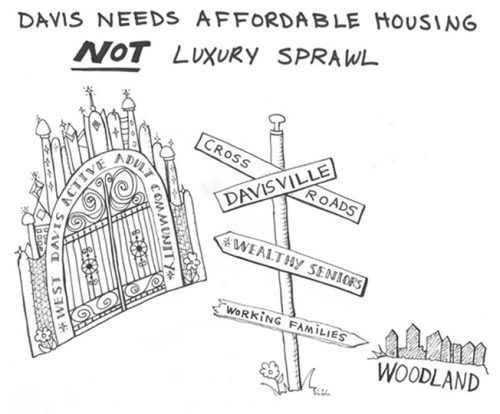
Against:
Arguments against Measure L claim irresponsible planning and developer giveaways/ subsidies from the city. How green is another low-density development on the edge of town? Do seniors really sell their houses (opening up housing stock), or do they hold onto them, detris-filled, until 20 years later their children inherit & turn them into overpriced student rentals with absentee landlords?
And what the F!*C&R@ is with this “Caring for Davis’ Own” rhetoric? Will preferential housing for those with Davis ties further white-ify our fair (skinned) city?
City of Davis Resolution 10-118 (passed in July 2010) recommends an independent market analysis to determine the need for senior & disabled housing, to include impacts on the Davis community at-large. But this analysis was never completed. Was it good judgement in shortening the bureaucratic process? Or a lack of due diligence?
Straw Poll:
Yes — 2; No — 10; Undecided & Abstainers — 2
We weren’t sure if we should be suspicious or not of the developer’s true intentions, so we erred on the side of caution and mostly voted NO – if the developers really want this project to go through, they’ll try again next ballot season. Maybe with less sprawl, no Davis-only requirement and no age discrimination!
Note: The illustrator admits a certain… bias…
—————————————————————————————-
Measure M — DJUSD Infrastructure Bonds
 Measure M is a bond measure to fund infrastructure costs at Davis Public Schools.
Measure M is a bond measure to fund infrastructure costs at Davis Public Schools.
Measure for measure, bond for bond, a bond by any other name is…a loan that the government takes out by lending money to people who buy bonds. Who buys bonds? People like your grandma, who don’t want to put their money in the stock market.
The debt on the bond (aka loan) will be serviced using a parcel tax (an annual premium on our real estate tax bill). This has the effect of further raising the cost of living in our fair city… for both homeowners and renters alike, as landlords typically pass costs like this on to tenants.
Amongst other things, this measure would: replace ancient portable buildings being used as classrooms; tackle buildings with persistent insect and pest problems, improve outdoor eating areas with shade structures, improve bike parking and car drop-off sites; update classroom technology; improve science facilities and MPR rooms; create a high school swimming pool.
An independent oversight committee would oversee expenditures. No money can be spent on administrator or teacher salaries.
Pro:
Davis public school infrastructure needs improvement; there is a little something for everyone school-minded in this measure. Health & safety would be improved at schools via new roofs, transportation improvements, security cameras, and better pest exclusion (reducing pesticide use). New spaces dedicated to science, music, arts instruction. Kids need to move, and there is no swimming pool nor adequate space for the wiggles at overcrowded lunch tables. All these things impact education quality.
Con: The official voter guide has no counter argument, so our brave presenter devised one for you. Namely — it is not equitable nor forward thinking for the City of Davis to improve our local children’s lot by taxing ourselves more while nearby districts with shallow pockets do not. Local school taxes make the privileged more privileged — insulate us from state/federal priorities (or lack thereof) and reduce the likelihood that our local residents will use their privileges to PUSH for greater educational funding for ALL.
Nearby districts in West Sac and Woodland do not typically improve their own infrastructure with local taxes. And what about places like… Stockton? Kern County? Heaven forbid!! Would not Davis residents time & money be better spent if we used all this bond money and campaigning energy to push for an educational revolution at the STATE and FEDERAL level that benefited ALL children?
Overheard (and paraphrased) discussion:
● “While I’m all for the education revolution, I’ve been waiting a long time. Our kids can’t wait — they need these changes now.”
● “It is easy to pick apart this bill and find things that bother me. Do we really need a swimming pool? Surveillance cameras don’t prevent crime, they just catch after-the-fact footage. We shouldn’t be investing more in cars and drop-off sites.. But I accept I cannot micromanage the process — I just hope the oversight committee does their job.”
● “As for equity, I like Measure M because it spends money evenly across all schools in our district, as opposed to direct donations to various PTAs. The fact is that most schools in our district don’t get as much state funding as schools with lower median income students. So we must make up the gap somehow, and I would rather pay across Davis Joint Unified School District (DJUSD) than donate to my own kid’s school. Let’s raise up all DJUSD schools equally.”
Straw Poll
Yes — 7; No — 5; Undecided/Abstain — 3
—————————————————————————————-
Davis School Board
Three people are running for school board! Well, make that three people who return phone calls. One person does not return phone calls (Chris Legal), nor does he deem it necessary to put a statement or bio in the Voter Guide. There are three open positions, so it makes it a pretty easy choice — especially since the three non-Chris candidates all seem highly qualified.
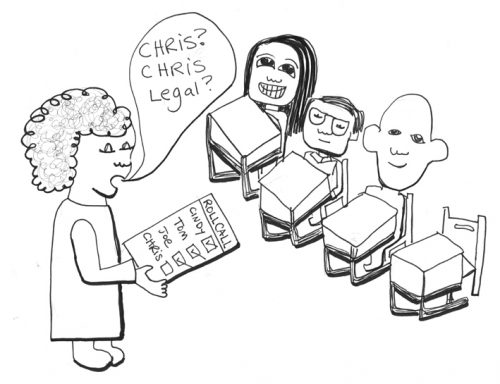 Cindy Pickett is a professor of psychology and a woman of color (yay!! yay!!) who is concerned about fair pay for teachers, school climate & the achievement gap. She presents as highly competent when you meet her, and is motivated to serve.
Cindy Pickett is a professor of psychology and a woman of color (yay!! yay!!) who is concerned about fair pay for teachers, school climate & the achievement gap. She presents as highly competent when you meet her, and is motivated to serve.
Joe DiNunzio is a business guy, teaches at the UCD Grad School of management, and has been highly active in the Willett PTA, is current president of the Davis Schools Foundation, pushed for the passage of Measure H, and is involved with the Davis Chamber of Commerce. Seems like he’d have a good head on the numbers, and he cares about reckoning with the budget.
Tom Adams is an incumbent, who’s worked for the CA Dept of Ed in Sac since 1997. He manages public education for a living — so he understands how the system works.
Seems like everyone is talking from the same “issue” sheet: transparency, achievement gap, school climate, inclusion. They each have different professional backgrounds, and hopefully that will make them a good team.
Presumably, that team won’t include Chris Legal, the guy who doesn’t return phone calls and who lists his address as “General Delivery, Davis.” This man of mystery, our voters deemed, is unelectable. Hard to vote for the underdog when he doesn’t’ show up…
Straw Poll
Pickett — 13; DiNunzio — 13; Adams — 13; Legal — 0
—————————————————————————————-
Yolo Board of Education, Area 2
What’s the difference between the Davis School Board and the county Board of Ed? Even though the job descriptions may sound similar, the biggest difference lies in the populations served. Our city’s School Board Trustees deal with issues specific to the DJUSD, while the County BofE serves students in the unincorporated areas (read: not in the cities but in the rural areas and small towns). It’s easy to imagine how different the challenges facing schools under the county’s responsibility are.
Now, the first question to answer is: is this even on my ballot? For many of you, the answer is NO because we are only voting in “Area 2,” otherwise known as Don Saylor’s supervisorial district. If you live in Provenza’s area, your trustee’s term isn’t up until 2020.
 If you live in Saylor’s district, you will choose between David Murphy and Melissa Moreno. The presenter here made sure to disclose that she’s biased towards Moreno for having kids at the same school and knowing her personally, but just being a friendly acquaintance of a person is never really a good reason to vote for her. RIGHT? Glad we all agree on that.
If you live in Saylor’s district, you will choose between David Murphy and Melissa Moreno. The presenter here made sure to disclose that she’s biased towards Moreno for having kids at the same school and knowing her personally, but just being a friendly acquaintance of a person is never really a good reason to vote for her. RIGHT? Glad we all agree on that.
No one in the assembled group had any specific concerns regarding David Murphy, a career administrator who spent 20 years as school superintendent (11 for the El Dorado Union High School District and 9 years for the DJUSD). But it’s clear that his experience derives from the issues of city school populations, not especially rural or migrant ones. Plus, isn’t he retired? What does he need this job for?
Moreno is younger, but she’s arguably better qualified for this role. Although she is busy as a professor and the Director of Ethnic Studies at Woodland Community College, she is willing to heed a call to public service because this is the arena she views as her life’s work: the creation of educational opportunities available to those who need them most. The daughter of farmworkers, she grew up in poverty, attended Head Start, Migrant Education, and English as a Second Language programs as a child. She went on to defy the odds by becoming the first elementary, high school, and college graduate in her family, and then to earn a Master’s and a Doctorate in Education. Providing quality education to traditionally underserved populations is not an academic question for her, it’s her own story.
Moreno’s got impressive endorsements. She’s got the passion. And she truly represents those she’s trying to serve. Give her the job, people!
Straw Poll
Moreno — 13; Murphy — 0; Abstain — 2

No, Not yet, We’ve still got to do the propositions.
CA Propositions
Prop 1 — Affordable Housing
This Prop funds existing affordable housing programs for low-income people, veterans, and farmworkers with $4 billion in general obligation bonds. Money would be split like this:
Program $ millions ~ # served
Affordable multi-family housing – loans to build/renovate $1,800 30,000 households
Infrastructure funds for building near public transit $450
Homeownership – down payment assistance $450 15,000 homebuyers
Farmworker housing – loans/grants to build $300 7,500 households
Veterans housing – home loan assistance $1,000 3,000 veterans
Veterans make monthly payments to the state for their home loans and the state uses their payments to repay bonds (proposed $1 billion), so there is no net cost to the state for that program. The other proposed $3 billion in bonds for housing programs would cost “about $170 million annually for 35 years” ($5.9 billion total, with interest). The state would have a competitive application process for the funds and General Fund revenues would pay off bonds.
Opposition was not able to raise any funds. General argument is that we shouldn’t be taking out more debt, but rely on private market to provide more affordable housing (Gee, that’s worked well so far!)
CA had 73 billion in debt from bonds and 31 in un-issued bonds. Bonds tend to seep into property taxes in the future. If bonds give the state gets more flexibility in the budget, hopefully they’ll do what we want them to (gotta hope for something).
Endorsements were read…the only no was the CA Republican Party. Over 300 million requires a vote from the public.
Support: Housing advocates, Construction unions, Democratic Party, Sierra Club
Opposition: Attorney Gary Wesley does not like bonds, Republican Party
Legislature: Divided, but mostly in favor (75%)
Straw Poll
Yes — 11; No — 1; Undecided — 1
—————————————————————————————-
Prop 2 — Homes for Mentally Ill Peeps
The gov is trying to free up more funds to deal with the housing crisis in the state. Prop 2 lets the state use $140 million per year of county mental health funds to pay for $2 billion in bonds for housing mentally ill homeless people. Prop 2 is on the ballot because it’s reallocating funds from Prop 63. Changes to ballot initiatives require a vote from the public.

Thus we were visited by a ghost of elections (and propositions) past…
I AM THE GHOST OF PROP 63….“People call me the Mental Health Services Act 3(MHSA), originally passed in 2004. I tax the wealthy, creating a specific stream of money for mental health care, but I am limited. Mentally ill parolees coming out of prison can’t be supported by my ghastly charms.”
Prop 2 funds housing for people with mental illness and allows the state to use MHSA money for this program. Onsite treatment in supportive housing with direct social services reduces public health costs associated with homelessness. Prop 2 requires police, mental health experts, and housing advocates to work together. Program is not being used as much by counties and this allows the gov to take money from that to put into housing.


Con(cerns):
* Could take money away from counties who are otherwise empowered to decide how to treat the mentally ill and could use those funds for housing if they think that’s what’s best in their county. The reallocation of funds to housing the homeless could result in treatment cuts that lead to homelessness. The prop doesn’t offer state protection against local zoning that prevents supportive housing from being built or state protection against discrimination from neighborhoods that don’t want severely mentally ill neighbors, so the funds might not get used for housing anyway.
*”I’m OK with supporting housing for people with mental illness, but not substance abuse problems. What’s the definition of mentally ill person in this bond?” Not clear. People with major mental illness often also have substance abuse issues. Trying to separate those issues as a policy matter is very difficult. People need a variety of services and the housing first movement seeks to provide services all in one place.
* Swap income tax for a bond? Seems like a raw deal! Income tax on the rich is better than a bond… Possibly means additional funding. Mental health agencies are split for and against it. Each a chapter of NAMI — I guess they vote independent, just like us…
* Do we look at addiction as illness? Cost with interest is 5.6 billion. Spending an immense amount of overhead to move money around(?). Can’t we just tax the rich more?
All major endorsements point to a “yes” vote. That includes both the CA Dem and Republican parties (!!). Also all the major newspapers throughout the state, the CA League of Women Voters, CA Labor Federation, CA Fed. of Teachers, CA Council of Churches, etc. Green Party says no on Prop 2 (but yes on 1) and Sierra Club takes no position.
One intrepid voter says, “I don’t know about you, but I am not even going to read the text given this level of bipartisan, cross-cultural support. YES for easy ones!”
Legislature: 107 yes, just one no!
Straw Poll
Yes – 10; No — 3, Undecided — 1
—————————————————————————————-
Now that we’ve solved the housing problem, let’s talk pancakes. First you make the batter, then you heat the pan. Ready? Almost…
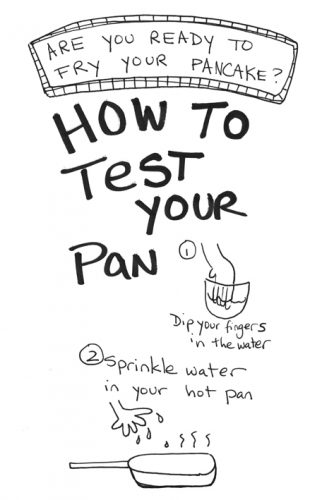

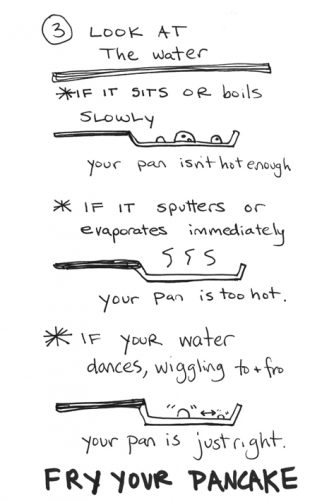

—————————————————————————————-
Prop 3 — Water, Water & More Water
Prop 3 would fund water and environmental projects with $8.9 billion in new bonds, costing the state about $430 million per year over 40 years. Prop 3 would save local governments about $200 million over the next 20-30 years by using prop 3 funds for projects that local governments might otherwise have funded.
Wait…didn’t they just ask to fund water projects for $4 billion in June with prop 68? Back so soon…thirsty for more.
We thought the legislature was supposed to address these needs, but the prop suggests that we don’t trust them to handle our $$. Instead of having the legislature allocate prop 3’s bond funds in the annual state budget, Prop 3 would send funds directly to state departments, who would distribute most of it via grants to local gov, tribes, and nonprofits for specific projects. The funds cannot go toward the evil twin tunnels water diversion project.
The prop has surface appeal with the 1.5 million acre feet of increased water supply, prioritizing low-income communities, water facility upgrades, improved drinking water, flood protection, etc. They’re saying that money can go out in a proportional way to local districts that are empowered to decide how to address water challenges. Also provides more $$ for the state to take care of existing dams (*cough* Oroville *cough*).
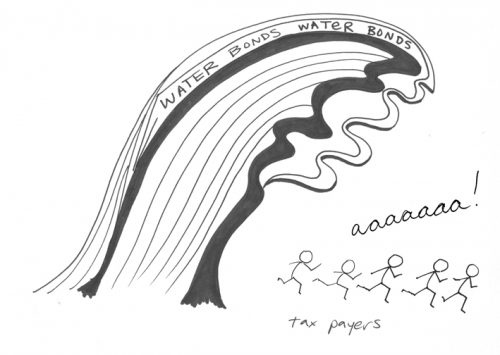

– Water bonds already passed in recent years haven’t done enough and this would be more of the same.
Endorsers are mostly water districts, most of them small, but some not so small. The Westlands water district (biggest & most troublesome in the state) is missing. The people opposed to it are the Sierra Club and Friends of the River. They’re talking dams, not the way to go. Not a balanced measure, paid for by water districts who want to build more dams. CA Democratic Party didn’t endorse and Republic party is neutral. Water districts tend to do things same ol’ same ol’.
There’s nothing much to show for bond money put toward water so far…Since 2000, $31 billion in bonds for water projects were approved by voters, and as of June about $10 billion was still available. Do we want to give politicians more funds to do more of the same that didn’t work?
Sustainable groundwater act is being implemented on the local water district level. Each local water district is working on creating a sustainable water plan for agriculture. Is there enough consideration for water that farmers need?
Straw Poll
No — 14; Yes — 0
—————————————————————————————-
Prop 4 — Children’s Hospitals


California Proposition 4, the Children’s Hospital Bonds Initiative, supports authorizing $1.5 billion in bonds for the construction, expansion, renovation, and equipping of children’s hospitals in California; a no vote opposes!
Let’s take a look at who’s behind this. On first blush, it has a lot of good support from all the major papers, the CA Dem party, CA Green party, etc. Who’s against? CA Republican party, CA Tea Party Coalition, CA League of Women Voters… wait a minute, this all made sense until that last bit.
What black magic aligns the League with the Tea Party on anything?
The official argument in favor was written by several pediatric doctors. The argument against was written by a guy named Gary Wesley (who doesn’t otherwise identify himself) who used his allotted space to rail against Prop 13. The Howard Jarvis Taxpayers Association wants to remind us all that ”bonds are not free money.”


Prop 4 would allow the state to sell bonds for children’s hospitals so that they can use it for new buildings, renovations, and equipment. It would cost about $80 million annually to repay the bonds. To be eligible for funding, hospitals have to provide care to children from low-income families who don’t have health insurance. Some of us don’t like bonds, but is it possible to vote against this and still be a decent human??
Bottom line: The League of Women Voters may have a valid point, but the great bulk of progressive California agencies urge us to pass this anyway. One can rationalize state funds supporting private facilities because they fill a tremendous need and will provide services to currently underserved kids across the state. We have four people present who have worked in medicine and healthcare finance for decades.,, they agree that we need a healthcare revolution, but that’s not coming anytime soon and in the meantime there are seriously ill children in need. Public facilities cannot meet even a fraction of the need and private hospitals need support in order to have the specialized infrastructure to serve children in their region. The private hospitals are non-profit. Wellllll….okay then…here’s for the kids! And for being decent humans.
Straw Poll
Yes – 11; No – 2; Undecided – 1
—————————————————————————————-
Prop 5 — Extend Prop 13 to Seniors
Gah! What?! An extension of prop 13? Usually, when someone moves into a new home, they pay property taxes based on what they just paid for their new home. However, there are currently some one-time exceptions (to Prop 13) that allow new homeowners who are 55 and older, severely disabled, or affected by a natural disaster to pay property taxes at a lower rate.
Wait, what’s prop 13? Could it be another ghost of elections past? Let’s hold seance…. Hold hands… lower the shades… ready?



THE GHOST OF ELECTIONS PAST PRONOUNCES….
“I am the ghost of Prop 13 (passed in 1974), who set property taxes at 1% of the value as assessed in 1974 — or when the property changed ownership or had new construction. I limited Prop Tax increases. I make new home buyer taxes high, and keep existing homeowner taxes low.”
Got that? Moving back to the present now… Prop 5 would expand Prop 13 exceptions so that they apply regardless of what county a homeowner moves to, for an unlimited number of moves, and so that if he/she moves to a more expensive home he/she wouldn’t have to pay as much in property taxes as they would under the current rules.
Property taxes go to public schools and local governments. The legislative analysis says that schools and local governments could lose over $100 million per year over the next few years and that annual loses could eventually grow to over $1 billion per year. The state would need to spend more money on these services instead.”
Proponents argue that when seniors move out of their oversized houses into smaller houses, this makes more family-sized housing available for younger generations. Opponents argue that prop 5 primarily benefits wealthy seniors and real estate agents, while doing nothing to ensure that homes are affordable to younger generations…and it hurts public schools! Ouch!
We foresee this hurting low-income rural counties the most when wealthy seniors retire there in more expensive homes than they had before…while paying relatively low property taxes. Counties won’t get to decide whether to allow this (as they currently have the power to do) and so a lot of their funding could potentially leave. Prop 5 doesn’t do much to help middle class and working class seniors or disabled people who already have the option of downsizing and keeping their tax break in participating counties.
The League of Women Voters is against it. CA Democratic and Republican parties endorse it. Opponents are the Berniecrats, newspapers, and the Green Party.
If we said “here’s for the kids!” on the last prop, why not do it for the seniors on this one? Yo, voties, ‘cause not all seniors need this assistance and this prop is not for need-based benefits.
Straw Poll
Yes — 0; No — 14; Undecided — 1
—————————————————————————————-
We interrupt your regularly scheduled politi-babble for a important breaking news.
We received an endorsement….


Join us at the next Politics & Pancakes gathering…
email: mindx@omsoft.com to get on our list!
Now back to our regularly programmed politi-talk…
Prop 6 – “Repeal the Gas and Car Registration Tax Increases”
or “Eliminates Certain Road Repair and Transportation Funding”.


The Presenter had seen it before. The Presenter tried their best to explain this from decades watching the pig-greased gears of Sacramento politics, as the assembled mass chewed on luscious fresh-made pancakes with real organic maple syrup. The Presenter failed. The assembled mass wanted their pancake, and they wanted to eat it, too. With syrup. They wanted their roads, their trains, their buses – their tired, their hungry their poor – everything the politicians promised. The Presenter wants those things too, but has seen it all before and it ends in Groundhog Day. Again. Transportation can’t continue to be rolled out, funded, stolen from, rolled out, funded, stolen from . . . enough is enough. But memories are short, and Sacrafatcat knows it.
In 2017, the politicians passed SB-1, and during the cold of winter when prices were low, the SB-1 tax was added to your local pump. It added about 12¢/gallon to the gas tax, the largest single gas-tax increase in US history, but on top of roughly 12¢/gallon in passed-on taxes from the oil companies for Cap & Trade. Cap & Trade also funds affordable housing and high-speed rail.
Prop 6, if passed, will overturn SB-1 and reduce gas taxes.
SB-1 is a regressive tax. Regressive tax increases hit the poor the most, because they hit everyone equal, but that’s unequitable because it takes a bigger % of total income when there ain’t as much income in a family. But the economy is cranking so nobody notices. For now.
Prop 6 stemmed from a local San Diego city-councilmember-turned-talk-show-host Carl DeMaio who got a politician recalled for voting for the SB-1 gas tax. Carl promoted the repeal initiative with the help of other talk show hosts. Carl and his group want to repeal the high-speed rail project in 2020 as their third bid. The governor didn’t like the name of their measure, and so pushed to have it changed and won that battle (thus the two names above).
SB-1 provides $5.2 billion per year for road and transit projects. Those projects are already out there and cranking away, so some will be stopped or delayed indefinitely if we all vote for 6.
Gavin wants to keep the fuel and registration taxes and keep the projects going. Cox wants to repeal the taxes and get the projects funded from previous funding sources — thus slowed and prioritized. Some agencies complain about inappropriate lobbying to keep the taxes – and others complain that the repealers have been robocalling (fake officially) that the ballot measure is misnamed.
The pro -6-side (for repeal) say: we already have Cap & Trade, previous initiatives to fund the roads,and the general fund. Legislators should go their job and prioritize state funds (and stop stealing from the till). Against 6 (for tax) say: we need the money for roads and transit and that there could be safety issues if money is not spent on roads and bridges and projects underway will be slowed or stopped. [Ed: and the legislature did their job by passing SB-1, no?] NO on 6 is also concerned that 6 contains constitutional amendment language that would make it impossible for the legislature to approve future gas taxes without voter approval. BTW, gas taxes are higher in the rest of the world than good ole CA– often with much better transit. Gas tax revenue has been dropping due to inflation and more efficient cars.
The YES on 6 (repeal) peeps include Republican party, Jarvis Taxpayers Assoc., yet the Repubs haven’t put up a whole lot to fund this ($4.4m). Pro-taxers (NO on 6) include counties, unions, construction trade, consultants, business associations (put up $31.5m).
Straw Poll:
Yeahs (1 — the presenter); Nahs — 14
The Presenter failed [Ed: both to present impartially, and to convince the assembled to vote Yeah on the repeal tax]. The Presenter hung their head in depress-peration, walked to a bridge, and jumped. Luckily for The Presenter, the bridge had never been built, because years ago the politicians stole the money for that bridge project and put it back in the general fund to spend as they pleased. So The Presenter didn’t die . . . or did they? (Does one die when they jump from a bridge that has never been built?)
—————————————————————————————-
Let’s move onto a simple issue… like the measurement of time…
Prop 7 – Permanent Daylight Saving
Our presenter disclosed that she hates when the time changes twice each year and that she was looking forward to finding a reason to vote “yes.” After that, everyone else in the group also disclosed that they, too, hate when the clocks must be changed. So, yeh. No one likes the status quo. But is that a good reason to vote yes on this particular version of change? Read on…
People read the actual language of the prop differently. Some in the group thought the initiative would have us on permanent Daylight time, some thought we’d be on permanent Standard time, some thought we’d be on neither unless (even after passage of Prop 7) California further petitions the federal government for a change. Whatever the interpretation, no one’s leanings seemed to be dependent on the details here.
The operative part of Prop 7 “permits the Legislature by two-thirds vote to make future changes to California’s daylight saving time period, including for its year-round application, if changes are consistent with federal law.” So it’s important to remember that nothing actually happens if/when we pass this thing. TWO additional hurdles must be hurdled – the feds must allow it, and then the state legislature must actively change things by a super majority. Nothing hasty here, folks. But passage of 7 would be a baby step towards eliminating the time discontinuities we now know and hate.
For the record, CA Dems, CA Republicans, and CA Greens are all for this! But all the major papers are against it, with the exception of the LA Times coming in with a weak endorsement.


The truth is that a change in any direction would affect most Californians broadly but shallowly. Kids who walk to school early in the morning would be affected in winter by potentially unsafe darkness. People with Seasonal Affective Disorder would either be happier or sadder, but not all would react the same way. And, studies have shown that DST has such limited energy-saving implications nowadays that it really doesn’t make a difference at all from an environmental perspective.
Looking at fiscal impact, there is “none stated” in the voter guide because the proposition doesn’t actually change anything (just allows the legislature to do so in the future). But it only takes a normal imagination to see that there are many ways, large and small, that economics will shift if DST becomes permanent. The one example I read repeatedly was that just keeping U.S. flights lined up with international travel schedules would cost $147 million a year. If this is true, what other fiscal impacts like this will emerge?
Bottom line: there’s a metric ton of data to read here if you want to. Heart attacks will go down! Heart attacks will go up! People will be safer or less safe! Energy use will go up. Or down! None of it is conclusive.
At poll time, the presenter remained undecided and pledged to keep reading. But a prevailing sentiment among those present went along the lines of “California has enough shit to deal with right now, we don’t need the unintended consequences that come with fixing things that ain’t broke.” The group was swayed in the “no” direction as follows:
The Straw Poll has it:
Yes — 0; No — 8 ; Completely Confused (or merely indecisive) — 5
—————————————————————————————-
Prop 8 — The Dialysis Doozy
Prop 8 would cap Chronic Dialysis Clinic revenue at 115% of direct patient care costs and healthcare improvement costs (“allowable expenses”). It was put on the ballot by a healthcare workers’ union.
While the intent is to raise wages for workers, improve clinic conditions, and reduce patient costs, there is a lot of uncertainty about how the clinics could respond and uncertainty about the fiscal effects, with much left open to interpretation by the California Dept of Public Health, the courts, and the clinics. It could make things better if the clinics and insurers choose to do what we hope they’ll do. Or it could make things worse. The clinics could respond to the revenue cap by increasing wages and benefits for non-managerial staff (“allowable costs”), but they might not…They could instead choose to cut other costs in ways that make things more difficult for workers and patients. The financial impact for state and local governments could be net positive in the tens of millions…or net negative in the tens of millions.
The legislative analysis says, ahem, “The rates that Medicare and Medi-Cal pay for dialysis treatment are relatively close to average cost for CDCs to provide a dialysis treatment and are largely determined by regulation,” soooooo the prop likely won’t have much effect as far as Medicare and Medi-Cal are concerned. The majority of dialysis is paid for by these two programs. As for private insurers (who pay multiple times what the government programs pay for dialysis)…even if private insurers pay less for dialysis treatment, we don’t trust that they’ll pass all (or any) of those savings on to the insured without being required.
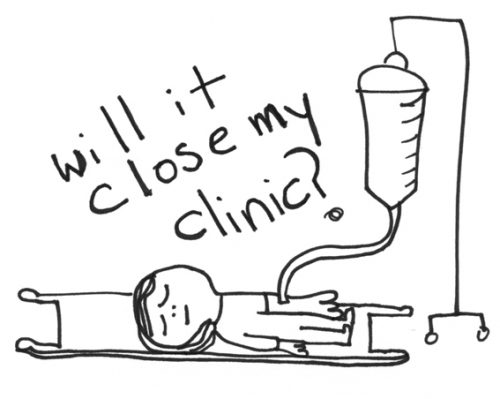

It’s hard to tell to what degree the clinics might respond by abruptly scaling back operations and forcing seriously ill patients into already over-burdened ERs, but the idea that that could be life-threatening or fatal for many is cause for a pause. Would the clinics will put their patients’ immediate needs above their profit margin in this battle? Seems doubtful.
If the outcome of this prop is not the outcome we want, the damage could be difficult to undo. Some of the underlying issues could be addressed more directly by the legislature and the health department. Hopefully just having it on the ballot gives the workers some leverage.
Straw Poll:
No no no — 13; Yuppers — 0; Indecisive — Zero


Prop 9 — Three State Initiative
Proposition 9 has been removed for your safety by the California Supreme Court.
This sock must never be divided.
It would unravel us all.
—————————————————————————————-
Prop 10 — Local Rent Control
YES VOTE = Gives local governments the power to choose to implement rent control.
Prop 10 repeals the Costa-Hawkins Rental Housing Act of 1995, allowing counties and cities to decide if and when to enact (or end) rent control policies.
Before Costa-Hawkins, county and city governments were allowed to enact rent control policies. Prop 10 returns that power to municipal governments, which in turn gives the poor more bargaining power for affordable housing.
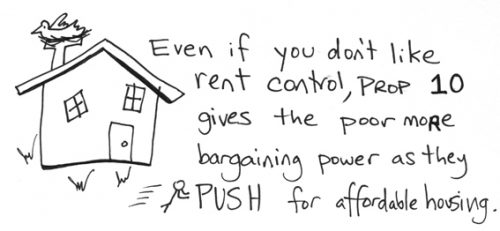

Do we need to say more? Empower your local governments against greedy slumlords! Vote YES on 10!…
… Oh wait… this is supposed to be an unbiased statement to inform voters… maybe we’ll put this another way:
YES on Prop 10…
Enable local governments to choose to establish rent control.
No… means no – don’t vote NO!
No means slumlords and outrageously high rental rates..


[Editor: Woah, woah, I remember the conversation going a little different from our dear presenter.
After all, our gathered voters included both renters & landlords. Some, indeed, wore both hats upon their tired patats
Arguments were made that rent control can cause properties to fall into disrepair, causing a dread of unsightliness.
Others — those renters present, said — rising rents don’t raise all ships (aka — slumlords don’t always make improvements even if they can raise the rents). Landlords can be really good at whining about their (lack of) profits, but sometimes it’s legit. Still, the YES argument was pretty convincing, despite all misgivings, for our crew….]
Straw Poll:
Eyes -13 Nays -1 Hmmms – 0
—————————————————————————————-


Prop 11 — Ambulance Workers Get All the Breaks
Ambulance workers’ meal breaks are sometimes interrupted by emergencies. This is offset by down-time between emergencies (aka calls) that allows workers enough time for a meal while they’re on call, just waiting around for the next crisis.
Prop 11 would allow ambulance workers to take meal breaks while on call (aka on the clock), exempting them from certain labor laws, but regulate the time frames that they can take those breaks. Ambulance workers are OK with this — they put forward a bill AB 263 to solve the problem. But the law didn’t pass, instead the legislature passed the dice onto us….
Prop 11 reduces liability (past & present) for ambulance companies. 11 says that private ambulance companies can’t be held liable for violating labor laws in the past (when they required ambulance workers to be on call during breaks in violation of state labor laws). If ambulance companies are required to pay for meal breaks for workers moving forward, costs will increase by $100 million. But this seems unlikely…. since the workers themselves are not asking for it.
Local governments with ambulance service contracts would probably save money through prop 11, as it voids old lawsuits.
Prop 11 requires private sector ambulance employers to provide additional natural disaster and active shooter training as well as provide access to mental health services for ambulance workers.


The legislature could just as easily make the BIG decision here re: more flexible breaks — with support from all sides. They almost did with AB 263 , but refused to chose “winners” between unions & private ambulance company AMR, re: pending lawsuits for sins & labor violations past.
AB 263 was supported by ambulance union — but not Prop 11.
Why are we voting on this? Send it BACK to the legislature. Vote NO to say “legislature, do your job! You bring everyone to the table — and you decide.”
The Straws Have It:
No — 8, Yes — 0; Undecided — 4
—————————————————————————————-
Prop 12 — Farm Animal Confinement


AKA what are you DOING to that chicken???
This is tough! The Humane Society and California Alliance with Family Farmers (CAFF) support it. The Humane Farming Association and People for the Ethical Treatment of Animals (PETA) are against it.
In 2008, voters passed prop 2, which said that egg laying hens and breeding female pigs needed to have enough space to turn around in their cages/crates by 2015. Some farms got rid of battery cages by 2015, as required, but there was no real enforcement and the space requirements were non-specific. Some thought it would be better to be specific about space requirements and not play loosey goosey with the birds. Prop 12 would require 144 square inches (1 square foot), which would be better for smaller hens — maybe still not enough for large hens.
While prop 12 does authorize the CA Department of Agriculture to enforce the standards, this would be logistically difficult and the enforcement of existing standards is already lacking. The idea that prop 12 would also regulate out-of-state producers by imposing the same requirements on them when they sell to California seems ambitious since we haven’t been effectively enforcing regulations here. Besides, is that even legal?
PETA is concerned that through the phase-in process hens would eventually be in cage-free sheds (by 2022) with only one square foot of space per hen. The stress they would experience from overcrowding could lead to the spread of disease and aggressive pecking. PETA says that the United Egg Producers wrote what they wanted as cage-free chicken guidelines in prop 12, and the guidelines allow for multi-level chicken factories where chickens are cage-free but over-crowded. PETA doesn’t want consumers to make the false assumption that chickens will be treated well and have enough space with prop 12.
It appears that prop 12 would be a better lot for pigs. Pigs are smart! BUT there aren’t many pigs in California — so arguably this is irrelevant — thus our discussion was more focused on chickens. We took a moment to appreciate that the eggs in our pancakes came from N Street hens with outdoor access and ample space. We could take a break and visit them if we want!
Cost-conscious concerns are that raising the standards would lead to increased food prices when the industry passes its buck (or lack thereof) on to consumers. According to Ballotpedia’s campaign finance section for prop 12, the industries that would be regulated haven’t funded an opposition campaign, which seems suspicious and maybe lends credibility to the argument that prop 12’s regulations are looser than prop 2’s. (Or were they reassured by the ban of sales from producers who don’t meet the requirements?)
There’s still some uncertainty about this prop and whether it could potentially make things worse for chickens. A majority of us leaned “no” in the straw poll. The presenter encouraged us to do more research.
Straw Poll:
No — 14; Undecided — 2; Yes — 0


CA Candidates
[Intentionally Left Blank for Candidates] (we had no time / energy to discuss)
Throw a dart & call it good. Agreed
U.S. Senate
Feinstein or De Leon? Who deserves our democratic vote?
Feinstein is the old guard — served as SF supervisor alongside Harvey Milk, later rose to mayor of San Francisco. She is the oldest serving US senator at 85 years lively.
Lady Feinstein is moderate for a democrat, party politics, not very progressive. She tends to vote yes on war, support big water, and does not exactly ride the vanguard of environmental sensibilities. She chaired the intelligence committee ‘til 2015. She can be counted on to support the democratic party platform: gun-control; women’s rights, labor rights/unions, health care, and immigrant rights. Loyalists say — she’s done a good job, elect her again!
But some say they want more — after all, Feinstein’s not going out on any limbs…
On to the Lion…
Kevin de Léon, fought for California healthcare (single-payer style), tuition-free college, pay equity, immigrant and civil rights, and made California a leader in the fight against climate change. He fought hard for Cap-and-Trade’s gains to be used in disadvantaged neighborhoods and include affordable housing (to reduce our need to MOVE our workers on a daily basis from low rent districts to high job ones).
De Leon is the face of the new California Democrat — a handsome face it is, the ladies (and some gentleman) say. A proven leader, he’s served as the CA State Senate’s President Pro Tempore. He’s charismatic, a champion for the rights of people of color & immigrants. Some complain his ambition is annoying — he’s run for Senate twice, against one of the most popular democrats ever (aka Lady Feinstein). Perhaps he’s just getting us used to seeing his name on the ballot…
Straw Poll:
Votes were cast, and alas, we were divided en masse:
5 – Feinstein
4 – De Leon
5 – Undecided
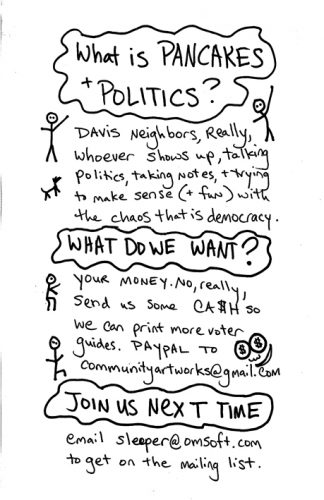



Measure L Straw Poll:Yes — 2; No — 10; Undecided & Abstainers — 2
Very interesting. I think this is a forebearer for next Tuesday.
Ghost must be suffering from “old-timer’s” dementia… prop 13 was passed in 1978.
I remember attending a small community meeting in San Mateo (thinking it was at Serra HS) where Howard Jarvis presented the pro for Prop 13… he was amiable, articulate, and somewhat deceptive. A guy I’d like as a neighbor, would shun as a leader. Unlike the unamiable, cynical, anti-government partner of his, Paul Gann (who I would just shun, across the board). My theory is that Gann convinced Jarvis that the cause would “sell”, and would be ‘good’ for seniors and others. Jarvis seems to have bought into the ‘message’, and was in his element as a salesman, who came across like your favorite uncle. He loved crowds, and was persuasive to many. But, as I thought about it, came to the conclusion it was bad public policy, and voted no.
That said, even tho’ am benefitting from some of its benefits, when I see how commercial properties have found ways to subvert the intent (Paul Gann would have “loved it”), I will vote against it (current proposal)… and would I’d favor repeal of the ‘portability’ that already exists. I do favor retaining the ‘inheritance’ exemption for direct descendents who occupy the family home as their own primary residence.
However you vote, if eligible, please vote. If eligible, and you don’t, you lose all rights (IMHO) to whine about the outcomes.
Maybe this will help those of you on the fence about Feinstein vs De Leon:
2005 – My Army son was sent to Iraq for what became known as needless war started under false pretenses (no weapons of mass destruction). I ran into Dianne Feinstein in a bathroom at a political event and had this conversation (paraphrased):
Laurie: “Dianne, you are the leader of the Appropriations committee which funds the wars and your husband’s Perini Corp. has a contract with the government to feed the troops, earning 16 million that year. How do you rationalize the conflict of interest and the making of millions off the lives of our loved ones with the fact that you are a Democratic leader?”
Dianne: “First, that is my husband’s company, not mine. Second, how dare you question my integrity after 30 years serving California (blah, blah, blah). ”
Laurie: Not the point!!
Also, our group of military families with loved one overseas had our Christmas Eve dinner peacefully in front of Dianne’s home with empty seats at the table to represent the family members who were not with us (including two who had been killed). She did not bother to come out and show any compassion. She does not represent us/me.
P.S – Over the course of the wars in Iraq and Afghanistan (still ongoing) her “husband’s” companies have made billions – financier Richard. C. Blum – see below
https://www.businesswire.com/news/home/20070125006150/en/Billions-Military-Contracts-Husbands-Firms-Approved-Sen.
We saw Feinstein’s true colors during the Kavanaugh hearings. She’s despicable.
And yet you don’t seem to mind Trump who is by far the most despicable public figure I have ever seen.
Whoa, good comeback.
Like you said the other day, I guess one sees things from whatever prospective they’re coming from.
I did see Feinstein at the Kavanaugh hearings. She demonstrated more restraint, dignity, and class than any of the GOP committee members (at least when they had the courage to question a witness themselves).
David… Trump is to [and his families] are to be more pitied than scorned. He is amoral, and worships at the altar of “the Don(ald)”.
From the Sacbee regarding Tony Mendoza.
“The 23-year-old, a Senate fellow placed by Sacramento State, turned down Mendoza, too, though he persisted. In August, Mendoza reportedly suggested the fellow spend the night in his hotel room before a golf-fundraiser at Cache Creek. She avoided the encounter by arriving the next morning.
A week later, after an Aug. 31 fundraiser at The Mix, he went to another evening event, and texted the young woman a photo of himself, repeating the invitation that she join him at a house in Natomas. He shares that house with Senate President Pro Tem Kevin de León.”
Now I were to solicit a 23 year old intern I would not invite to my home as my wife is there and she might be negative. Clearly Tony knew Kevin would be OK the scene or he would have suggested a hotel.
Five years ago my wife’s goddaughter was incarcerated incommunicado at one of the ORR black sites and I had to extricate her. I called both Boxer and Feinstein. Boxer, may she burn in hell, could not bother to return the call. Feinstein’s people at least tried to be helpful. Constituent service is 100 times more important to me than political outlook.
Same feelings about Boxer… [edited]
Your first and last sentences are spot on.
Our representatives, when they listen, and weigh input, and act on that and their principles are good. Those who feel “it’s all about their views”, not so much…
Boxer is to Democrats, as Trump is to moderate Republicans (and most cognizant folk). A loathsome aberration. But it is what it is.
Thread cleanup: 5 comments removed.